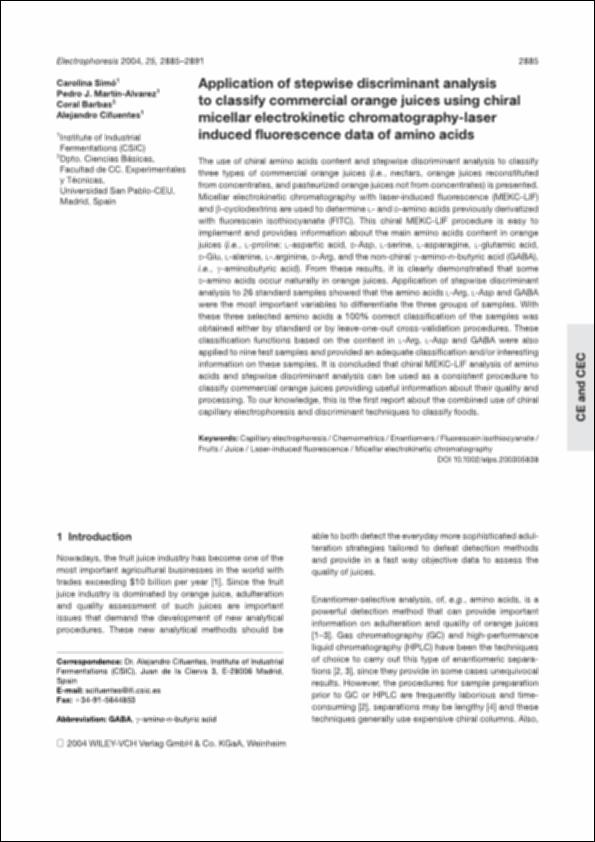Por favor, use este identificador para citar o enlazar este ítem:
http://hdl.handle.net/10637/863Application of stepwise discriminat analysis to classify commercial orange juices... : some applications in food analysis.
| Título : | Application of stepwise discriminat analysis to classify commercial orange juices... : some applications in food analysis. |
| Autor : | Simó, Carolina Martín-Alvarez, Pedro J. Barbas Arribas, Coral. Cifuentes, Alejandro |
| Materias: | Capillary electrophoresis.; Chemometrics.; Enantiomers.; Fluorescein isothiocyanate.; Fruits.; Juice.; Laser-induced fluorescence.; Micellar electrokinetic chromatography. |
| Resumen : | The use of chiral amino acids content and stepwise discriminant analysis to classify three types of commercial orange juices (i.e., nectars, orange juices reconstituted from concentrates, and pasteurized orange juices not from concentrates) is presented. Micellar electrokinetic chromatography with laser-induced fluorescence (MEKC-LIF) and b-cyclodextrins are used to determine L- and D-amino acids previously derivatized with fluorescein isothiocyanate (FITC). This chiral MEKC-LIF procedure is easy to implement and provides information about the main amino acids content in orange juices (i.e., L-proline; L-aspartic acid, D-Asp, L-serine, L-asparagine, L-glutamic acid, D-Glu, L-alanine, L-.arginine, D-Arg, and the non-chiral g-amino-n-butyric acid (GABA), i.e., g-aminobutyric acid). From these results, it is clearly demonstrated that some D-amino acids occur naturally in orange juices. Application of stepwise discriminant analysis to 26 standard samples showed that the amino acids L-Arg, L-Asp and GABA were the most important variables to differentiate the three groups of samples. With these three selected amino acids a 100% correct classification of the samples was obtained either by standard or by leave-one-out cross-validation procedures. These classification functions based on the content in L-Arg, L-Asp and GABA were also applied to nine test samples and provided an adequate classification and/or interesting information on these samples. It is concluded that chiral MEKC-LIF analysis of amino acids and stepwise discriminant analysis can be used as a consistent procedure to classify commercial orange juices providing useful information about their quality and processing. To our knowledge, this is the first report about the combined use of chiral capillary electrophoresis and discriminant techniques to classify foods. |
| Descripción : | En: Electrophoresis, ISSN 1522-2683, 2004, 25 : 2885-2891 pp |
| URI : | http://hdl.handle.net/10637/863 |
| Derechos: | http://creativecommons.org/licenses/by-nc-nd/4.0/deed.es |
| Fecha de publicación : | 19-sep-2004 |
| Centro : | Universidad San Pablo-CEU |
| Aparece en las colecciones: | Facultad de Farmacia |
Los ítems de DSpace están protegidos por copyright, con todos los derechos reservados, a menos que se indique lo contrario.


